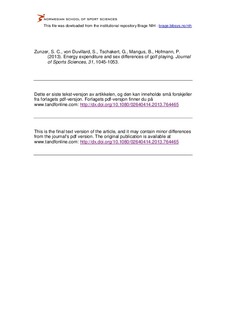| dc.contributor.author | Zunzer, Stefan C. | |
| dc.contributor.author | von Duvillard, Serge P. | |
| dc.contributor.author | Tschakert, Gerhard | |
| dc.contributor.author | Magnus, Brent | |
| dc.contributor.author | Hofmann, Peter | |
| dc.date.accessioned | 2014-04-08T11:11:22Z | |
| dc.date.available | 2014-04-08T11:11:22Z | |
| dc.date.issued | 2013-01-30 | |
| dc.identifier | Seksjon for fysisk prestasjonsevne / Department of Physical Performance | |
| dc.identifier.citation | Journal of Sports Sciences. 2013, 31, 1045-1053 | nb_NO |
| dc.identifier.uri | http://hdl.handle.net/11250/194076 | |
| dc.description | I Brage finner du siste tekst-versjon av artikkelen, og den kan inneholde ubetydelige forskjeller fra forlagets pdf-versjon. Forlagets pdf-versjon finner du på www.tandfonline.com: http://dx.doi.org/10.1080/02640414.2013.764465 / In Brage you'll find the final text version of the article, and it may contain insignificant differences from the journal's pdf version. The original publication is available at www.tandfonline.com: http://dx.doi.org/10.1080/02640414.2013.764465 | nb_NO |
| dc.description.abstract | The purpose of the study was to assess the average physical intensity and energy expenditure during a single round of golf on hilly and flat courses in a heterogeneous group of healthy men and women of varying age and golf handicap. Forty-two males and 24 females completed an incremental cycle-ergometer exercise test to determine exercise performance markers. The heart rate (HR), duration, distance, walking speed, ascent and descent were measured via a global positioning system (GPS)/HR monitor during the game and energy expenditure was calculated. Playing 9 or 18-holes of golf, independent of the golf course design, the average HR was not significantly different between sexes or the subgroups. The intensities were light with respect to the percentage of maximal HR and metabolic equivalents of task (METs). Total energy expenditure of all participants was not significantly different for hilly (834 ± 344 kcal) vs. flat courses (833 ± 295 kcal) whereas male players expended significantly greater energy than female players (926 ± 292 vs. 556 ± 180 kcal), but did not have significantly greater relative energy expenditure (2.8 ± 0.8 vs. 2.2 ± 0.7 METs). As a high volume physical activity, playing golf is suggested to yield health benefits. Since the intensity was well below recommended limits, golf may have health related benefits unrelated to the intensity level of the activity. | nb_NO |
| dc.language.iso | eng | nb_NO |
| dc.publisher | Taylor & Francis | nb_NO |
| dc.subject | VDP::Samfunnsvitenskap: 200::Samfunnsvitenskapelige idrettsfag: 330::Andre idrettsfag: 339 | nb_NO |
| dc.subject | high volume | nb_NO |
| dc.subject | low intensity | nb_NO |
| dc.subject | golf course design | nb_NO |
| dc.subject | exercise performance | nb_NO |
| dc.title | Energy expenditure and sex differences of golf playing | nb_NO |
| dc.type | Journal article | nb_NO |
| dc.type | Peer reviewed | nb_NO |
| dc.source.journal | Journal of Sports Sciences | nb_NO |
| dc.identifier.doi | 10.1080/02640414.2013.764465 | |
